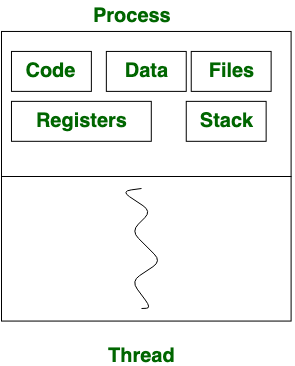Difference between Process and Thread
 The Process and Thread are the essentially associated. The process is an execution of a program whereas thread is an execution of a program driven by the environment of a process.
The Process and Thread are the essentially associated. The process is an execution of a program whereas thread is an execution of a program driven by the environment of a process.
Another major point which differentiates process and thread is that processes are isolated with each other whereas threads share memory or resources with each other.
Content: Process Vs Thread
- Comparison Chart
- Definition
- Key Differences
- Conclusion
Comparison Chart
| BASIS FOR COMPARISON | PROCESS | THREAD |
|---|---|---|
| Basic | Program in execution. | Lightweight process or part of it. |
| Memory sharing | Completely isolated and do not share memory. | Shares memory with each other. |
| Resource consumption | More | Less |
| Efficiency | Less efficient as compared to the process in the context of communication. | Enhances efficiency in the context of communication. |
| Time required for creation | More | Less |
| Context switching time | Takes more time. | Consumes less time. |
| Uncertain termination | Results in loss of process. | A thread can be reclaimed. |
| Time required for termination | More | Less |
Difference between Process and Thread
Process:
Process means any program is in execution. Process control block controls the operation of any process. Process control block contains the information about processes for example: Process priority, process id, process state, CPU, register etc. A process can creates other processes which are known as Child Processes. Process takes more time to terminate and it is isolated means it does not share memory with any other process.
Thread:
Thread is the segment of a process means a process can have multiple threads and these multiple threads are contained within a process. A thread have 3 states: running, ready, and blocked.
Thread takes less time to terminate as compared to process and like process threads do not isolate.

Difference between Process and Thread:
| S.NO | PROCESS | THREAD |
|---|---|---|
| 1. | Process means any program is in execution. | Thread means segment of a process. |
| 2. | Process takes more time to terminate. | Thread takes less time to terminate. |
| 3. | It takes more time for creation. | It takes less time for creation. |
| 4. | It also takes more time for context switching. | It takes less time for context switching. |
| 5. | Process is less efficient in term of communication. | Thread is more efficient in term of communication. |
| 6. | Process consume more resources. | Thread consume less resources. |
| 7. | Process is isolated. | Threads share memory. |
Multiprocessing in Python
What is multiprocessing?
Multiprocessing refers to the ability of a system to support more than one processor at the same time. Applications in a multiprocessing system are broken to smaller routines that run independently. The operating system allocates these threads to the processors improving performance of the system.
Why multiprocessing?
Consider a computer system with a single processor. If it is assigned several processes at the same time, it will have to interrupt each task and switch briefly to another, to keep all of the processes going.
This situation is just like a chef working in a kitchen alone. He has to do several tasks like baking, stirring, kneading dough, etc.
So the gist is that: The more tasks you must do at once, the more difficult it gets to keep track of them all, and keeping the timing right becomes more of a challenge.
This is where the concept of multiprocessing arises!
A multiprocessing system can have:
- multiprocessor, i.e. a computer with more than one central processor.
- multi-core processor, i.e. a single computing component with two or more independent actual processing units (called “cores”).
Here, the CPU can easily executes several tasks at once, with each task using its own processor.
It is just like the chef in last situation being assisted by his assistants. Now, they can divide the tasks among themselves and chef doesn’t need to switch between his tasks.
Multiprocessing in Python
In Python, the multiprocessing module includes a very simple and intuitive API for dividing work between multiple processes.
Let us consider a simple example using multiprocessing module:
# importing the multiprocessing module import multiprocessing def print_cube(num): """ function to print cube of given num """ print("Cube: {}".format(num * num * num)) def print_square(num): """ function to print square of given num """ print("Square: {}".format(num * num)) if __name__ == "__main__": # creating processes p1 = multiprocessing.Process(target=print_square, args=(10, )) p2 = multiprocessing.Process(target=print_cube, args=(10, )) # starting process 1 p1.start() # starting process 2 p2.start() # wait until process 1 is finished p1.join() # wait until process 2 is finished p2.join() # both processes finished print("Done!") |
Square: 100 Cube: 1000 Done!
Let us try to understand the above code:
- To import the multiprocessing module, we do:
import multiprocessing
- To create a process, we create an object of Process class. It takes following arguments:
- target: the function to be executed by process
- args: the arguments to be passed to the target function
Note: Process constructor takes many other arguments also which will be discussed later. In above example, we created 2 processes with different target functions:
p1 = multiprocessing.Process(target=print_square, args=(10, )) p2 = multiprocessing.Process(target=print_cube, args=(10, ))
- To start a process, we use start method of Process class.
p1.start() p2.start()
- Once the processes start, the current program also keeps on executing. In order to stop execution of current program until a process is complete, we use join method.
p1.join() p2.join()
As a result, the current program will first wait for the completion of p1 and then p2. Once, they are completed, the next statements of current program are executed.
Let us consider another program to understand the concept of different processes running on same python script. In this example below, we print the ID of the processes running the target functions:
# importing the multiprocessing module import multiprocessing import os def worker1(): # printing process id print("ID of process running worker1: {}".format(os.getpid())) def worker2(): # printing process id print("ID of process running worker2: {}".format(os.getpid())) if __name__ == "__main__": # printing main program process id print("ID of main process: {}".format(os.getpid())) # creating processes p1 = multiprocessing.Process(target=worker1) p2 = multiprocessing.Process(target=worker2) # starting processes p1.start() p2.start() # process IDs print("ID of process p1: {}".format(p1.pid)) print("ID of process p2: {}".format(p2.pid)) # wait until processes are finished p1.join() p2.join() # both processes finished print("Both processes finished execution!") # check if processes are alive print("Process p1 is alive: {}".format(p1.is_alive())) print("Process p2 is alive: {}".format(p2.is_alive())) |
ID of main process: 28628 ID of process running worker1: 29305 ID of process running worker2: 29306 ID of process p1: 29305 ID of process p2: 29306 Both processes finished execution! Process p1 is alive: False Process p2 is alive: False
- The main python script has a different process ID and multiprocessing module spawns new processes with different process IDs as we create Process objects p1 and p2. In above program, we use os.getpid() function to get ID of process running the current target function.Notice that it matches with the process IDs of p1 and p2 which we obtain using pid attribute of Process class.
- Each process runs independently and has its own memory space.
- As soon as the execution of target function is finished, the processes get terminated. In above program we used is_alive method of Process class to check if a process is still active or not.
Consider the diagram below to understand how new processes are different from main Python script:

So, this was a brief introduction to multiprocessing in Python. Next few articles will cover following topics related to multiprocessing:
- Sharing data between processes using Array, value and queues.
- Lock and Pool concepts in multiprocessing
##################################################
from multiprocessing import Process
import os
def info(title):
print(title)
print('module name:', __name__)
print('parent process:', os.getppid())
print('process id:', os.getpid())
def f(name):
info('function f')
os.system('python plt1.py')
print('hello', name)
if __name__ == '__main__':
info('main line')
p = Process(target=f, args=('bob',))
p.start()
print("I am here")
p.join()
###########################################################
#####PROCESS FORK
from multiprocessing import Process
import os
def info(title):
print(title)
print('module name:', __name__)
print('parent process:', os.getppid())
print('process id:', os.getpid())
def f(name):
info('function f')
os.system('python plt1.py')
print('hello', name)
if __name__ == '__main__':
info('main line')
p = Process(target=f, args=('bob',))
p.start()
print("I am here")
p.join()
################
import multiprocessing
import time
class Process(multiprocessing.Process):
def __init__(self, id):
super(Process, self).__init__()
self.id = id
def run(self):
self.print_loop()
def print_loop(self):
for i in range(10):
time.sleep(1)
print("I'm the process with id: {}".format(self.id))
if __name__ == '__main__':
p = Process(0)
p.start()
p1 = Process(1)
p1.start()
p.join()
p.join()
